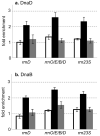Co-directional replication-transcription conflicts lead to replication restart
- PMID: 21350489
- PMCID: PMC3059490
- DOI: 10.1038/nature09758
Co-directional replication-transcription conflicts lead to replication restart
Abstract
Head-on encounters between the replication and transcription machineries on the lagging DNA strand can lead to replication fork arrest and genomic instability. To avoid head-on encounters, most genes, especially essential and highly transcribed genes, are encoded on the leading strand such that transcription and replication are co-directional. Virtually all bacteria have the highly expressed ribosomal RNA genes co-directional with replication. In bacteria, co-directional encounters seem inevitable because the rate of replication is about 10-20-fold greater than the rate of transcription. However, these encounters are generally thought to be benign. Biochemical analyses indicate that head-on encounters are more deleterious than co-directional encounters and that in both situations, replication resumes without the need for any auxiliary restart proteins, at least in vitro. Here we show that in vivo, co-directional transcription can disrupt replication, leading to the involvement of replication restart proteins. We found that highly transcribed rRNA genes are hotspots for co-directional conflicts between replication and transcription in rapidly growing Bacillus subtilis cells. We observed a transcription-dependent increase in association of the replicative helicase and replication restart proteins where head-on and co-directional conflicts occur. Our results indicate that there are co-directional conflicts between replication and transcription in vivo. Furthermore, in contrast to the findings in vitro, the replication restart machinery is involved in vivo in resolving potentially deleterious encounters due to head-on and co-directional conflicts. These conflicts probably occur in many organisms and at many chromosomal locations and help to explain the presence of important auxiliary proteins involved in replication restart and in helping to clear a path along the DNA for the replisome.
Figures




Similar articles
-
The B. subtilis Accessory Helicase PcrA Facilitates DNA Replication through Transcription Units.PLoS Genet. 2015 Jun 12;11(6):e1005289. doi: 10.1371/journal.pgen.1005289. eCollection 2015 Jun. PLoS Genet. 2015. PMID: 26070154 Free PMC article.
-
Replication Restart after Replication-Transcription Conflicts Requires RecA in Bacillus subtilis.J Bacteriol. 2015 Jul;197(14):2374-82. doi: 10.1128/JB.00237-15. Epub 2015 May 4. J Bacteriol. 2015. PMID: 25939832 Free PMC article.
-
Accelerated gene evolution through replication-transcription conflicts.Nature. 2013 Mar 28;495(7442):512-5. doi: 10.1038/nature11989. Nature. 2013. PMID: 23538833 Free PMC article.
-
What happens when replication and transcription complexes collide?Cell Cycle. 2010 Jul 1;9(13):2537-43. doi: 10.4161/cc.9.13.12122. Cell Cycle. 2010. PMID: 20581460 Free PMC article. Review.
-
Replisome structure suggests mechanism for continuous fork progression and post-replication repair.DNA Repair (Amst). 2019 Sep;81:102658. doi: 10.1016/j.dnarep.2019.102658. Epub 2019 Jul 8. DNA Repair (Amst). 2019. PMID: 31303546 Free PMC article. Review.
Cited by
-
Modulation of DNA damage tolerance in Escherichia coli recG and ruv strains by mutations affecting PriB, the ribosome and RNA polymerase.Mol Microbiol. 2012 Nov;86(3):675-91. doi: 10.1111/mmi.12010. Epub 2012 Sep 7. Mol Microbiol. 2012. PMID: 22957744 Free PMC article.
-
The nature of mutations induced by replication–transcription collisions.Nature. 2016 Jul 7;535(7610):178-81. doi: 10.1038/nature18316. Epub 2016 Jun 29. Nature. 2016. PMID: 27362223 Free PMC article.
-
Bacteria can maintain rRNA operons solely on plasmids for hundreds of millions of years.Nat Commun. 2023 Nov 14;14(1):7232. doi: 10.1038/s41467-023-42681-w. Nat Commun. 2023. PMID: 37963895 Free PMC article.
-
An underlying mechanism for the increased mutagenesis of lagging-strand genes in Bacillus subtilis.Proc Natl Acad Sci U S A. 2015 Mar 10;112(10):E1096-105. doi: 10.1073/pnas.1416651112. Epub 2015 Feb 23. Proc Natl Acad Sci U S A. 2015. PMID: 25713353 Free PMC article.
-
The Clash of Macromolecular Titans: Replication-Transcription Conflicts in Bacteria.Annu Rev Microbiol. 2018 Sep 8;72:71-88. doi: 10.1146/annurev-micro-090817-062514. Epub 2018 Jun 1. Annu Rev Microbiol. 2018. PMID: 29856930 Free PMC article. Review.
References
-
- Rocha EP. The replication-related organization of bacterial genomes. Microbiology. 2004;150:1609–1627. - PubMed
-
- French S. Consequences of replication fork movement through transcription units in vivo. Science. 1992;258:1362–1365. - PubMed
-
- Olavarrieta L, Hernandez P, Krimer DB, Schvartzman JB. DNA knotting caused by head-on collision of transcription and replication. J Mol Biol. 2002;322:1–6. - PubMed
Publication types
MeSH terms
Substances
Grants and funding
LinkOut - more resources
Full Text Sources
Other Literature Sources
Molecular Biology Databases

